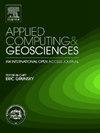Electrical anisotropy calculation of the continental crust by resistor network-based circuit simulations
IF 3.2
Q2 COMPUTER SCIENCE, INTERDISCIPLINARY APPLICATIONS
引用次数: 0
Abstract
Electrical anisotropy has been broadly observed by magnetotelluric (MT) surveys in the continental crust. It is proposed to be caused by rock microfabrics, lithologic layering, or oriented alignment of fluid or melt in rocks, whereas the validity of these mechanisms has not yet been verified due to the lack of experimental and computational evidence. Laboratory measurements on the electrical anisotropy of crustal rocks are extremely challenging when considering microfabrics and oriented microcracks filled with fluid. In contrast, numerical modeling, being an efficient approach, can be used to compute the anisotropic physical properties of rocks. In this study, the electrical anisotropy of crustal rocks was first modeled by circuit simulation techniques using a random resistor network model, based on the lattice-preferred orientation, modal compositions, and mineral electrical conductivity. The results indicate that the conversion from single crystals to the corresponding aggregates leads to a great reduction in electrical anisotropy, particularly for quartz single crystal with high anisotropy. Moreover, the electrical anisotropy of two-phase aggregates decreases with the increasing proportion of the second low-anisotropy minerals (e.g., plagioclase), such as from quartzite to granite. For layered lithology, the lower-crustal gabbro has higher electrical anisotropy compared to middle-crustal quartz-bearing rocks. The modeled electrical anisotropy from the middle to lower crust matches well with the geophysical observations in the Central Great Basin.
基于电阻网络的大陆地壳电性各向异性计算电路模拟
大陆地壳电性各向异性在大地电磁测量中得到了广泛的观察。它被认为是由岩石微组构、岩性分层或岩石中流体或熔体的定向排列引起的,然而由于缺乏实验和计算证据,这些机制的有效性尚未得到验证。当考虑到充满流体的微结构和定向微裂缝时,对地壳岩石电性各向异性的实验室测量极具挑战性。而数值模拟是计算岩石各向异性物理性质的有效方法。在这项研究中,首先通过电路模拟技术,利用随机电阻网络模型,基于晶格优选取向、模态组成和矿物电导率,模拟了地壳岩石的电各向异性。结果表明,从单晶到相应的聚集体的转变导致电各向异性的显著降低,特别是对于具有高各向异性的石英单晶。两相团聚体的电性各向异性随第二低各向异性矿物(如斜长石)的比例增加而降低,如从石英岩到花岗岩。对于层状岩性,下地壳辉长岩电性各向异性高于中地壳含石英岩。模拟的中下地壳电性各向异性与中央大盆地的地球物理观测结果吻合较好。
本文章由计算机程序翻译,如有差异,请以英文原文为准。
求助全文
约1分钟内获得全文
求助全文
来源期刊

Applied Computing and Geosciences
Computer Science-General Computer Science
CiteScore
5.50
自引率
0.00%
发文量
23
审稿时长
5 weeks
 求助内容:
求助内容: 应助结果提醒方式:
应助结果提醒方式:


